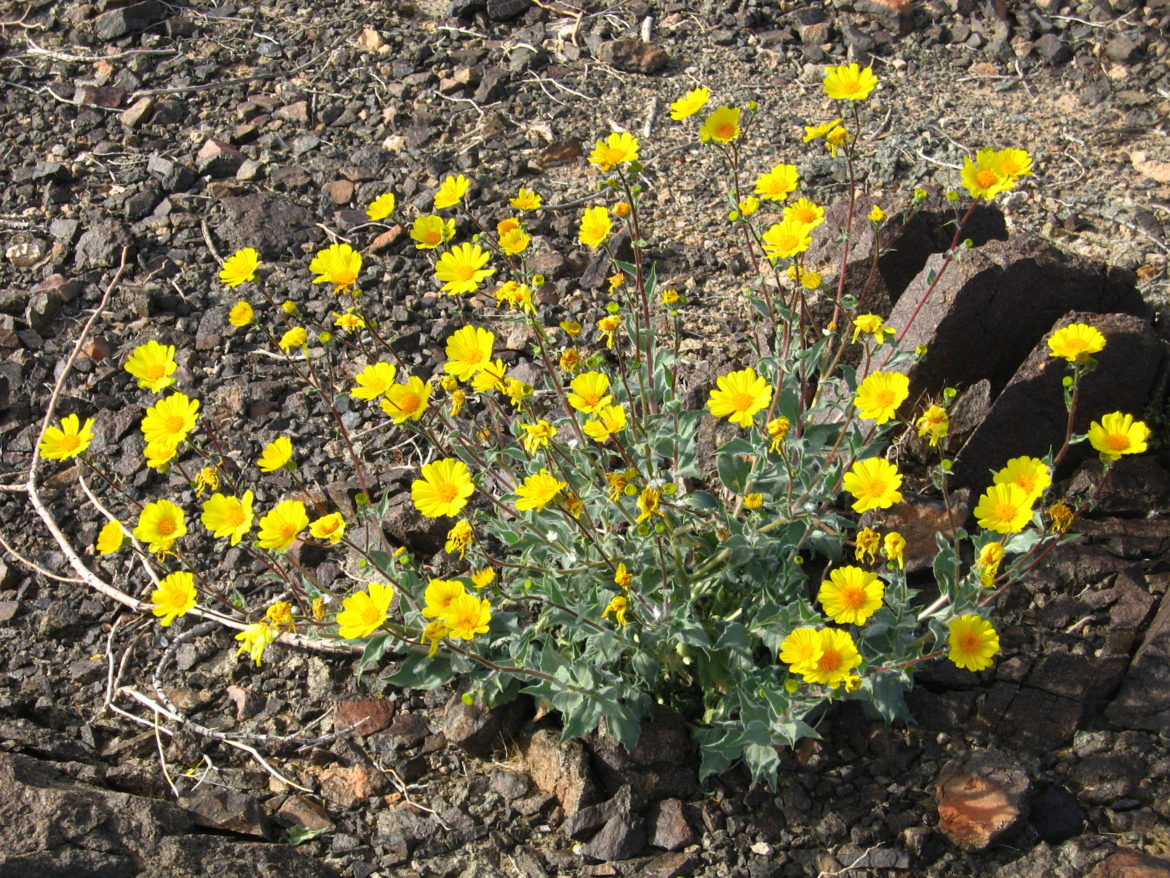 by Dottie Holman
by Dottie HolmanWith all the rain we have had this fall and winter, we’ll be enjoying more wildflowers (and weeds) than in prior years. The ever-ending question is “which is which?” As with many other things, the answer is in the eye of the beholder. A “weed” is often defined as a plant that is growing where it is not wanted. However, the same plant growing in a field or where it does not interfere with our planned landscape is called a “wildflower.” This article will review just a few plants we commonly see blooming this time of year either in our yards and roadways. Whether you want to eradicate these plants from your yard or include them, familiarity will increase your appreciation for their uniqueness and beauty.
Two wildflowers (or weeds) which people do need to be able to distinguish are the Scorpionweed and the Arizona Lupine. Scorpionweed (Phacelia crenulata) is in the Boraginaciae Family. It grows to about 16 inches tall and has violet-purple bell-shaped flowers in finely haired, terminal coils. The dark green, hairy leaves are much divided and up to five inches long. The name “scorpionweed” refers to the curling flowerheads which somewhat resembles the flexed tail of a scorpion in striking position. Any contact with Scorpionweed can produce a skin rash very similar to poison oak. Therefore, be aware of walking through scorpionweed or of pets running through it. The plant fibers can be transferred to you by your clothing or pet’s fur.
The Arizona Lupine (Lupinus arizonicus) is a member of the Fabaceae Family (pea family). This annual has pale pink to purplish blooms, but is usually a slightly paler color than the Scorpionweed flower and blooms in an erect spear above bright green, palmately divided leaves. Lupines are among the old dependables of spring flower displays. The name “lupine” comes from the Latin word meaning “wolf” and was applied to this plant because it was believed to rob the soil of its fertility. Actually, in common with other members of the Pea Family, it is capable of fixing nitrogen in the soil and actually improves the land on which it grows.
The Desert Sunflower is a common spring wildflower seen growing at this time. In favorable years, the desert sunflower forms magnificent displays of golden yellow color. It can grow up to three feet tall and has very hairy, grayish-green, diamond-shaped leaves that are three inches long. This annual is very fragrant, and is attractive to bees and hummingbird moths. The seeds are food for small rodents and birds.
Another yellow-colored wildflower you can see around town right now is a member of the Evening Primrose Family and is commonly called Yellow-Cups. This lovely flower can grow up to almost two feet tall and has bright yellow flowers with four cup-shaped petals. The leaves are green with a reddish tinge growing mostly in a basal rosette. This evening primrose blooms at sunrise instead of sunset like some of the other evening primroses.
Spanish Needle is an annual, which is very prevalent in Lake Havasu City, especially in the spring and again in the fall, provided there have been summer rains. It usually grows about one to two feet high and has somewhat thin and long, dark green leaves, which are extremely bitter in taste. The pinkish, pincushion-like flowers when finished leave a skeleton framework resembling crossed needles, hence the name.
Sahara Mustard (Brassica tournefortii) is an invasive weed that has multiplied in enormous amounts here in Lake Havasu. If this weed goes unchecked it will become our number one weed problem and will place scorpion weed as number two on the list. Sahara mustard is commonly known as African mustard, Asian mustard or wild turnip and is a member of the mustard family. This is no ordinary weed and is very destructive. It is an early bloomer (December/January) and grows quickly, therefore using resources such as water and nutrients around it before other plants can emerge. It will smother wildflowers such as lupine, poppies, and verbena along with native plants such as creosote bush. The plant also has high oxalic content so it may be toxic to our desert tortoises and because of its aggressive growth pattern affect wildlife by altering the availability of forage plants and habitat structure.
Identifying Sahara mustard is easy. Many of us may think it as a wildflower because of the yellow flowers that it produces but don’t let it fool you. Sahara mustard is an erect annual that can grow from four to forty inches tall. The stems branch from the base of the plant and have rough, stinging hairs that can be hurtful if touched (but is not poisonous like scorpion weed and will not leave a rash). When the leaves are crushed they smell like cabbage or turnips. The basal rosette of the leaves can be three to twelve inches long and look like that of a dandelion plant. The leaves get smaller as they grow up the stem. The flowers are small, less than a quarter of an inch, with four oblong yellow petals in the shape of an X. This flower will then turn into a fruit. The fruits are narrow seed capsules that break open when mature and disperse seeds. One well-developed plant can produce between 750-9,000 seeds. Tests have shown that Sahara mustard may be self-fertile since fruit set is nearly 100% on most plants and can still germinate after sitting three years in dormancy. The best control is prevention and the best prevention is manual pulling of this plant prior to “going to seed.”
These are only a few of the wildflowers/weeds that we can see in our own yards or neighborhoods at this time of year. Take a few minutes to enjoy their beautiful blooms and unique characteristics that allow them to live in our desert. At the same token, eradicate the “bad guys” by putting down pre-emergent or pulling out the entire plant.


